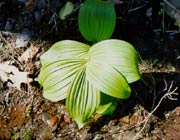Green false hellebore
| subsp. var. | ||||||||||||||||||||||||||||||||||||||||||||||||||||||||
|---|---|---|---|---|---|---|---|---|---|---|---|---|---|---|---|---|---|---|---|---|---|---|---|---|---|---|---|---|---|---|---|---|---|---|---|---|---|---|---|---|---|---|---|---|---|---|---|---|---|---|---|---|---|---|---|---|

|
|
| ||||||||||||||||||||||||||||||||||||||||||||||||||||||
| ||||||||||||||||||||||||||||||||||||||||||||||||||||||||
| Standard Cyclopedia of Horticulture |
|---|
|
Veratrum viride, Linn. American White Hellebore. Indian Poke. Fig. 3908. A hardy perennial, 2-7 ft. high: root-stock 2-3 in. long: lvs. plicate, acute, the lower oval, about 1 ft. long, the upper gradually smaller: fls. yellowish green; segms. oblong or oblanceolate, ciliate, serrulate; pedicels 1-3 lines long. July. N. Amer. B.B. 1:408. B.M. 1096 (as Helonias viride). Gn. 62, p. 283.
|
| Green false hellebore {{{status}}} Fossil range: {{{fossil_range}}}
| ||||||||||||||||||||||||||||||||||||||||||||||||||||||||||||||||||
|---|---|---|---|---|---|---|---|---|---|---|---|---|---|---|---|---|---|---|---|---|---|---|---|---|---|---|---|---|---|---|---|---|---|---|---|---|---|---|---|---|---|---|---|---|---|---|---|---|---|---|---|---|---|---|---|---|---|---|---|---|---|---|---|---|---|---|
 Green false hellebore in Delaware Water Gap National Recreation Area | ||||||||||||||||||||||||||||||||||||||||||||||||||||||||||||||||||
| Plant Info | ||||||||||||||||||||||||||||||||||||||||||||||||||||||||||||||||||
| ||||||||||||||||||||||||||||||||||||||||||||||||||||||||||||||||||
| Scientific classification | ||||||||||||||||||||||||||||||||||||||||||||||||||||||||||||||||||
| ||||||||||||||||||||||||||||||||||||||||||||||||||||||||||||||||||
| [[{{{diversity_link}}}|Diversity]] | ||||||||||||||||||||||||||||||||||||||||||||||||||||||||||||||||||
| {{{diversity}}} | ||||||||||||||||||||||||||||||||||||||||||||||||||||||||||||||||||
| Binomial name | ||||||||||||||||||||||||||||||||||||||||||||||||||||||||||||||||||
| Veratrum viride Aiton | ||||||||||||||||||||||||||||||||||||||||||||||||||||||||||||||||||
| Trinomial name | ||||||||||||||||||||||||||||||||||||||||||||||||||||||||||||||||||
| {{{trinomial}}} | ||||||||||||||||||||||||||||||||||||||||||||||||||||||||||||||||||
| Type Species | ||||||||||||||||||||||||||||||||||||||||||||||||||||||||||||||||||
| {{{type_species}}} | ||||||||||||||||||||||||||||||||||||||||||||||||||||||||||||||||||
| {{{subdivision_ranks}}} | ||||||||||||||||||||||||||||||||||||||||||||||||||||||||||||||||||
| [[Image:{{{range_map}}}|{{{range_map_width}}}|]] | ||||||||||||||||||||||||||||||||||||||||||||||||||||||||||||||||||
| Synonyms | ||||||||||||||||||||||||||||||||||||||||||||||||||||||||||||||||||
| {{{synonyms}}} |
Green false hellebore (American white hellebore, Bear Corn, Big Hellebore, Devil's Bite, Duck Retten, Indian Poke, Itch-weed, Itchweed, Poor Annie, and Tickleweed; Veratrum viride) is a perennial plant that grows from small leek-like shoots in the spring to a medium-sized plant with spectacular leaves. It is known for being extremely toxic, and for this reason is considered a pest plant by farmers with livestock.
Botanical properties
The adult plant can reach 3 to 5 feet, with even extra length when a floral stem is present. It has a solid white stem with large, broad alternate leaves ending in a short point, heavily ribbed and hairy on the underside. It grows numerous 2 cm lime-green to citrus-yellow flowers in a large inflorescence. Rarely goes into flowers.
Veratrum species are used as food plants by the larvae of some Lepidoptera species including Setaceous Hebrew Character.
Ecological
Green false hellebore is found in wet areas of forests. It prefers deciduous forest but is also found well in the north of boreal forest.
Distribution and multiplication
Green false hellebore is found from the Alaska through the Olympic, Cascade Range and Rocky Mountains south down to northern California. In the east, its distribution goes from Georgia north to Labrador.
The plant multiplies through its rhizome and seeds.
Medicine
The plant is highly toxic, causing nausaea and vomiting. If the poison is not evacuated, cold sweat and vertigo appears. Respiration slows, cardiac rhythm and blood pressure falls, eventually leading to death.
It is used externally by several Amerindian nations for external treatment. Although is rarely ever used modern herbary due to its concentration of various alkaloids, it has been used in the past against high blood pressure and rapid heartbeat. The root contains even higher concentrations than the aerial parts.
Trivia
The plant was used by some tribes to elect a new leader: all the candidates would eat the root, and the last to start vomiting would become the new leader.[1]
Notes
- ↑ Fleurbec, p.27
References
- http://www.wnps.org/plants/veratrum_viride.html
- http://collections.ic.gc.ca/hazeltons/hellbore.htm
- http://www.ibiblio.org/pfaf/cgi-bin/arr_html?Veratrum+viride&CAN=LATIND
- http://plants.usda.gov/java/profile?symbol=VEVI
- http://ghs.gresham.k12.or.us/science/ps/nature/gorge/3petal/lily/green.htm wayback machine
- Fleurbec Group (ed), 1981, Plantes cauvages comestibles. Saint-henri-de-Lévis, Quebec, Canada. ISBN 2-920174-03-7